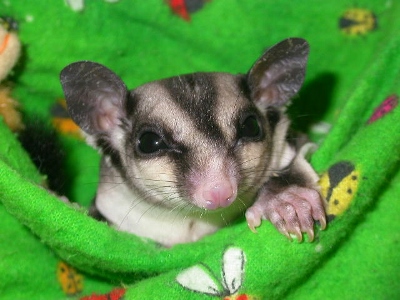
The sugar glider is gliding out of the spotlight as our Animal of the Month for December. If you’ve been following us on Twitter @ExoticPetVets, you will have seen all of the fun and fascinating facts we tweeted about these sociable little creatures. Here is a summary in case you missed any of our tweets. Did you know?:
- Sugar gliders (Petaurus breviceps) are small mammals native to Australia, Indonesia, Papua New Guinea & related islands.
- The sugar gliders’ scientific name means “short-headed rope dancer” in Latin.
- Sugar gliders are arboreal, meaning they live in trees.
- In the wild, sugar gliders are often found in rainforests and coastal areas.
- Sugar gliders are often mistaken for rodents, but they’re actually marsupials.
- Like koalas and kangaroos, the sugar glider also carries her babies in a front pouch for about 8 weeks after they’re born.
- Baby sugar gliders are called joeys and are about the size of a pea or a grain of rice when they’re born.
- Female sugar gliders will give birth to two babies at a time.
- When they’re fully grown, sugar gliders will be about 5 – 7 inches in length, with another 5 – 7 inches of tail length.
- Sugar gliders are nocturnal, meaning they are most active at night and sleep during the day.
- Large eyes help sugar gliders see at night.
- The first part of the sugar glider’s name refers to the animal’s love of sweet foods.
- Sugar gliders are omnivorous, meaning they will eat both plant and animal matter.
- In the wild, sugar gliders have a varied diet that includes pollen, nectar, seeds, insects, small lizards and birds.
- In captivity sugar gliders should be fed pelleted kibble + a nectar/sap-based mix + limited insects, fruits and veggies.
- Never give chocolate (or any other candy) or dairy products to sugar gliders.
- If not fed a proper diet, sugar gliders can suffer from calcium deficieny.
- A vet who treats sugar gliders can give proper and thorough nutritional guidance for sugar gliders in captivity.
- The second part of the sugar glider’s name refers to the animal’s ability to glide between trees with a flap of the skin.
- Sugar gliders have a skin membrane that connects their front and hind legs.
- Stretching this flap of skin creates a kind of built-in “parachute” for sugar gliders. They can glide for up to 50 metres.
- Sugar gliders, flying squirrels and colugos (aka “flying lemurs”) are the only living mammals with the ability to glide.
- Usually living in groups of 6-10 in the wild, sugar gliders are very social animals.
- Sugar gliders can be found sleeping snuggled together in the hollows of trees.
- Because of their social nature, sugar gliders should not be kept alone in captivity.
- If properly socialized, sugar gliders in captivity can develop very strong bonds with humans.
- Once bonded, sugar gliders in captivity will want to be near other members of the family.
- Sugar gliders in captivity are known for their love of riding around in people’s pockets.
- Sugar gliders also form lifelong bonds with other household pets like cats, dogs and some birds.
- Since sugar gliders aren’t rodents, they don’t smell like rodents and cats and dogs are likely not to see them as prey.
- Although native to parts of Australia, sugar gliders are not native to the island of Tasmania.
- It’s believed sugar gliders were introduced to Tasmania by people in the 1800’s.
- Australian researchers say sugar glider predation could lead to the extinction of Tasmania’s swift parrot.

